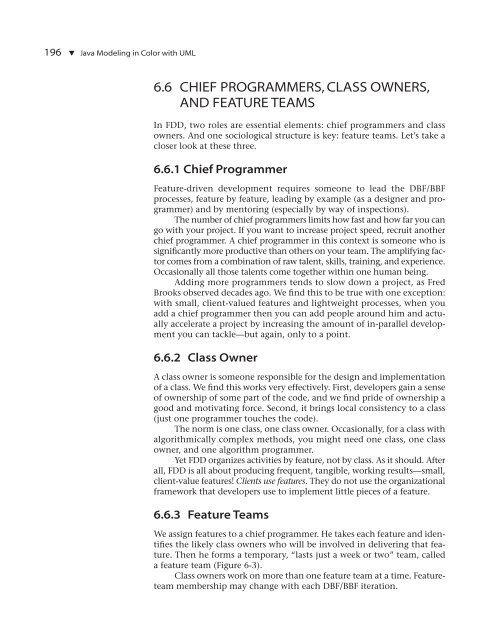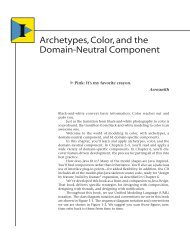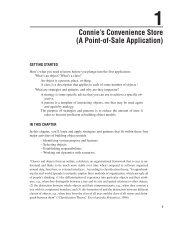Feature-Driven Development - About Peter Coad
Feature-Driven Development - About Peter Coad
Feature-Driven Development - About Peter Coad
You also want an ePaper? Increase the reach of your titles
YUMPU automatically turns print PDFs into web optimized ePapers that Google loves.
196 ▼ Java Modeling in Color with UML<br />
6.6 CHIEF PROGRAMMERS, CLASS OWNERS,<br />
AND FEATURE TEAMS<br />
In FDD, two roles are essential elements: chief programmers and class<br />
owners. And one sociological structure is key: feature teams. Let’s take a<br />
closer look at these three.<br />
6.6.1 Chief Programmer<br />
<strong>Feature</strong>-driven development requires someone to lead the DBF/BBF<br />
processes, feature by feature, leading by example (as a designer and programmer)<br />
and by mentoring (especially by way of inspections).<br />
The number of chief programmers limits how fast and how far you can<br />
go with your project. If you want to increase project speed, recruit another<br />
chief programmer. A chief programmer in this context is someone who is<br />
significantly more productive than others on your team. The amplifying factor<br />
comes from a combination of raw talent, skills, training, and experience.<br />
Occasionally all those talents come together within one human being.<br />
Adding more programmers tends to slow down a project, as Fred<br />
Brooks observed decades ago. We find this to be true with one exception:<br />
with small, client-valued features and lightweight processes, when you<br />
add a chief programmer then you can add people around him and actually<br />
accelerate a project by increasing the amount of in-parallel development<br />
you can tackle—but again, only to a point.<br />
6.6.2 Class Owner<br />
A class owner is someone responsible for the design and implementation<br />
of a class. We find this works very effectively. First, developers gain a sense<br />
of ownership of some part of the code, and we find pride of ownership a<br />
good and motivating force. Second, it brings local consistency to a class<br />
(just one programmer touches the code).<br />
The norm is one class, one class owner. Occasionally, for a class with<br />
algorithmically complex methods, you might need one class, one class<br />
owner, and one algorithm programmer.<br />
Yet FDD organizes activities by feature, not by class. As it should. After<br />
all, FDD is all about producing frequent, tangible, working results—small,<br />
client-value features! Clients use features. They do not use the organizational<br />
framework that developers use to implement little pieces of a feature.<br />
6.6.3 <strong>Feature</strong> Teams<br />
We assign features to a chief programmer. He takes each feature and identifies<br />
the likely class owners who will be involved in delivering that feature.<br />
Then he forms a temporary, “lasts just a week or two” team, called<br />
a feature team (Figure 6-3).<br />
Class owners work on more than one feature team at a time. <strong>Feature</strong>team<br />
membership may change with each DBF/BBF iteration.




